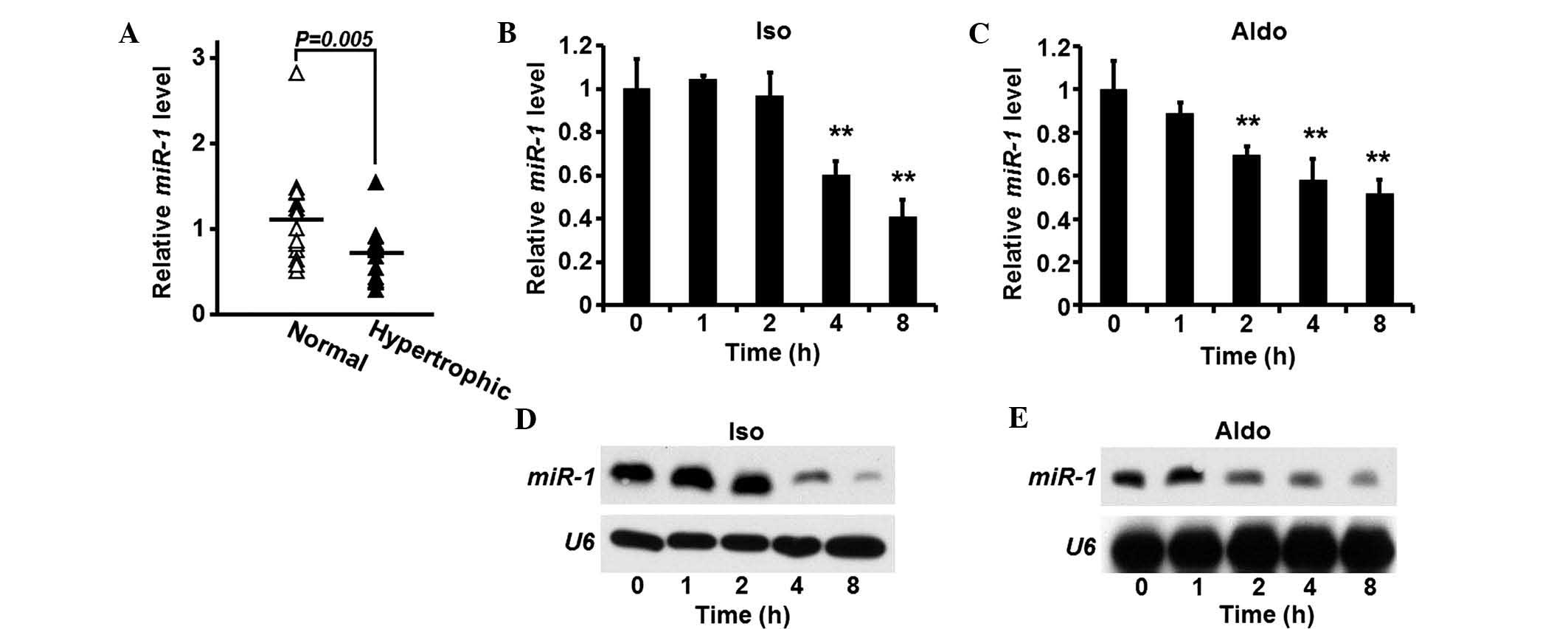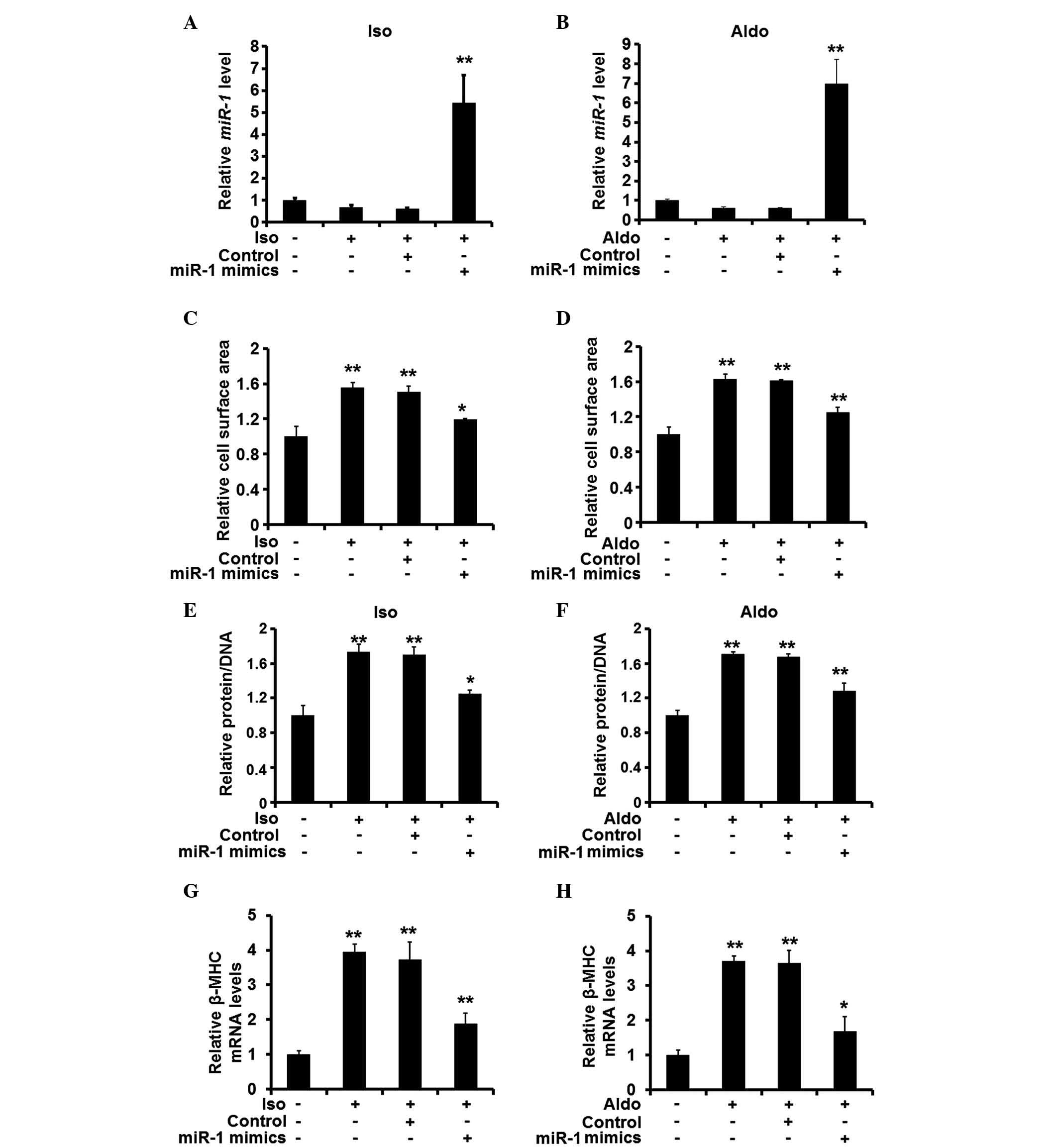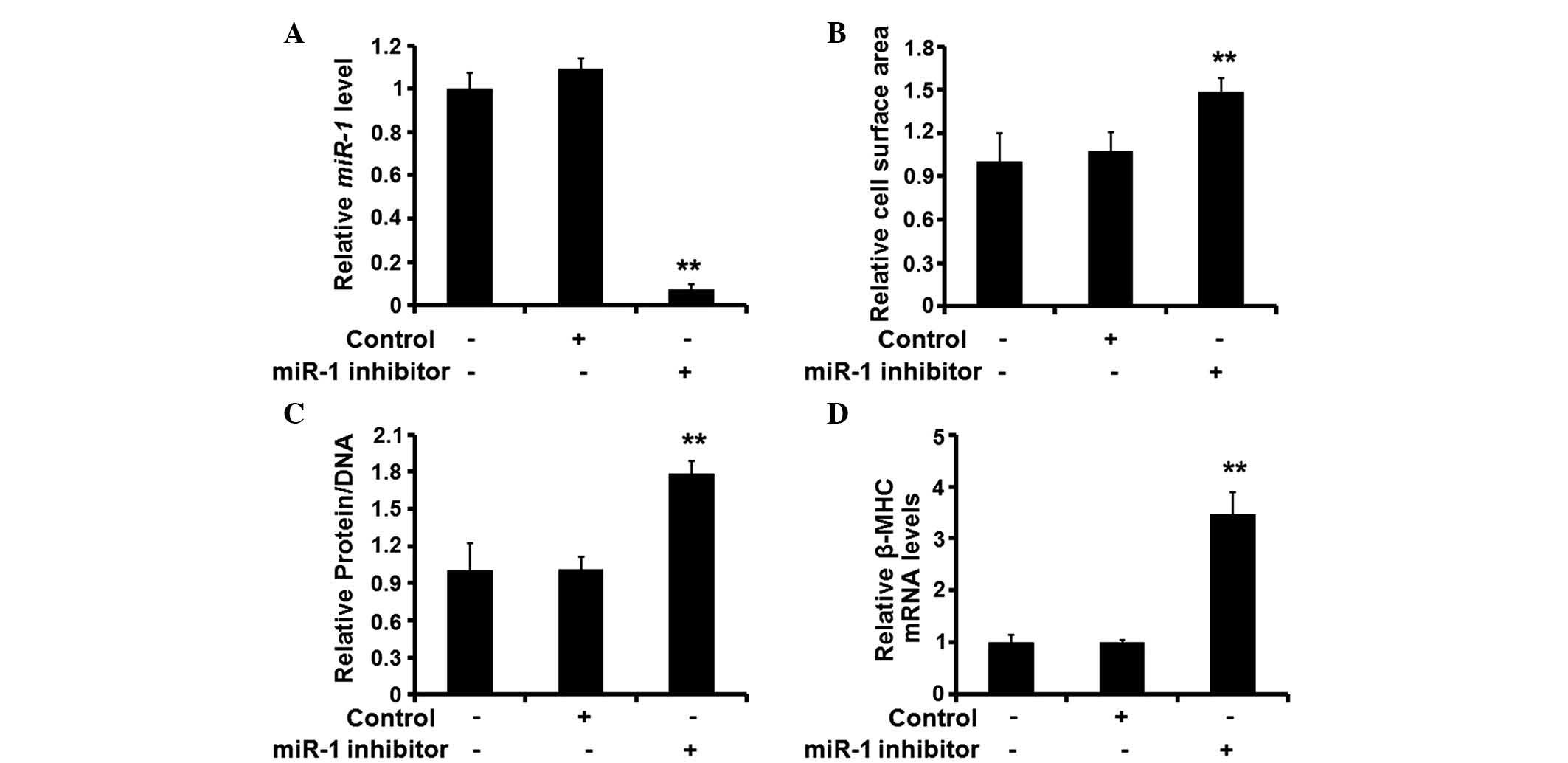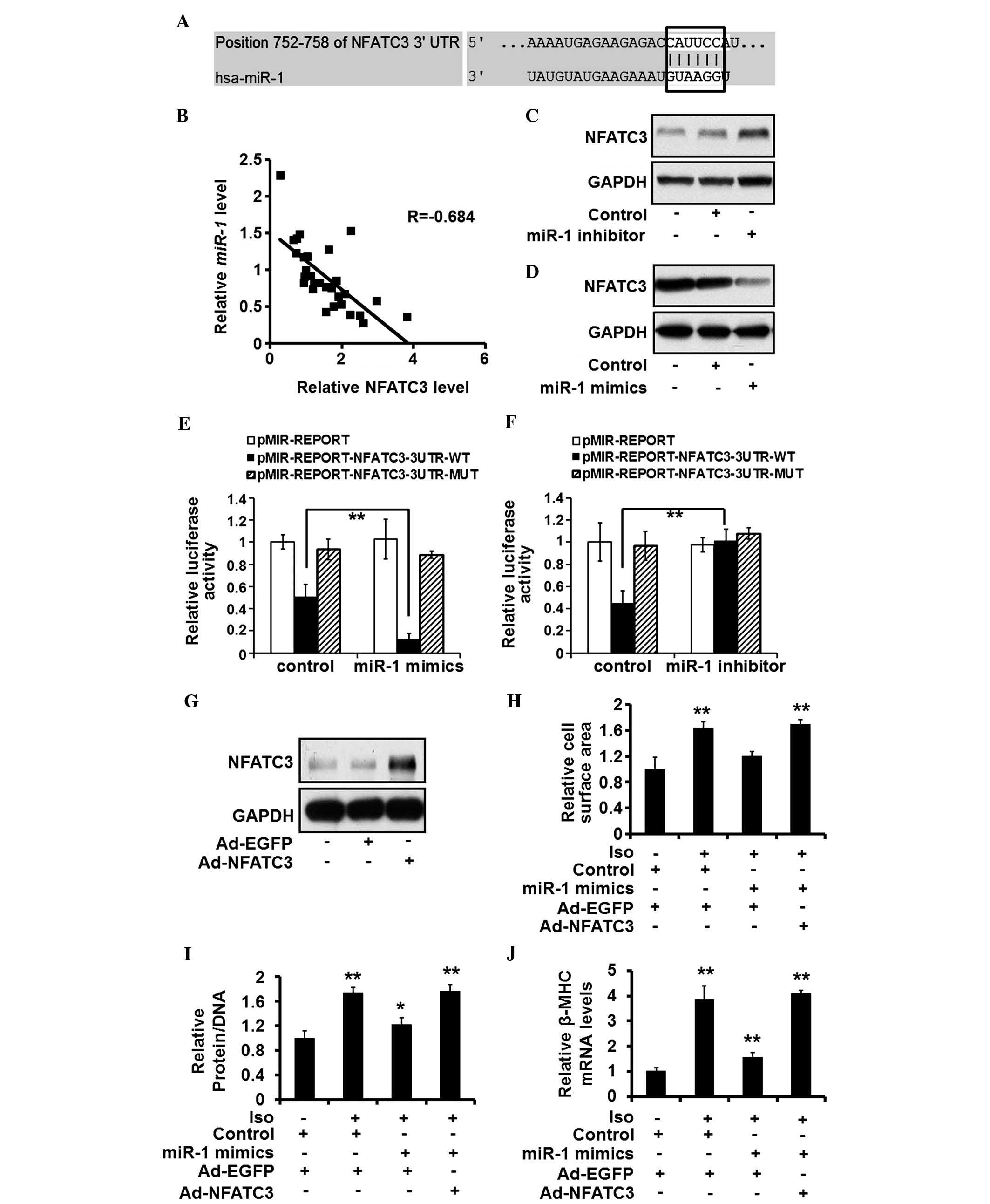MicroRNA‑1 suppresses cardiac hypertrophy by targeting nuclear factor of activated T cells cytoplasmic 3
- Authors:
- Published online on: October 14, 2015 https://doi.org/10.3892/mmr.2015.4441
- Pages: 8282-8288
Abstract
Introduction
Cardiomyocyte hypertrophy is a compensatory heart response towards harmful stimuli, and patients with cardiomyocyte hypertrophy usually have a poor prognosis, with the onset of heart systolic and diastolic dysfunction, and ultimately sudden heart failure-induced mortality (1). In order to develop novel therapeutic strategies, the molecular pathways underlying cardiomyocyte hypertrophy require further elucidation.
MicroRNAs (miRNAs; miRs) belong to a group of 20–22 nucleotide-long non-coding RNAs, which suppress the expression of target mRNAs by binding their 3′-untranslated region (UTR) in a miRNA recognition element (MRE)-dependent mechanism (2). Accumulated evidence has demonstrated that miRNA is closely associated with the initiation and progression of cardiomyocyte hypertrophy (3). miR-1 has been demonstrated to suppress cardiac hypertrophy by decreasing the expression levels of calmodulin and Mef2a (4). The anti-hypertrophic effect of miR-1 may also be associated with the insulin-like growth factor signaling pathway (5), the twinfilin-1 cytoskeleton regulatory protein (6), NCX1 and AnxA5 proteins (7). The introduction of miR-1 was demonstrated to reverse the pathological remodeling induced by pro-hypertrophic stimuli (8). Isoproterenol (ISO) is a β-adrenoceptor activator, which has been confirmed to exert cardioprotective effects by promoting the expression of miR-1 (9). Notably, cardiac miR-1 abundance can be indirectly detected by evaluating the serum expression levels of fatty acid binding protein 3 in patients with cardiomyocyte hypertrophy, suggesting that miR-1 is a promising diagnostic biomarker for susceptibility to cardiomyocyte hypertrophy (10). These findings indicate that miR-1 is an attractive epigenetic factor regulating cardiac hypertrophy. However, the downstream effectors of miR-1 have not been examined in full.
Nuclear factor of activated T cells cytoplasmic 3 (NFATC3) is important in the initiation and progression of cardiomyocyte hypertrophy. Calcineurin is a serine/threonine protein phosphatase, which dephosphorylates NFATC3, resulting in its nuclear localization, and these events lead to the pathological remodeling of hypertrophic cardiomyocytes (11,12). However, the regulatory pathways located upstream of NFATC3, particularly miRNAs targeting this pro-hypertrophic factor, remain to be fully elucidated.
The present study aimed to investigate the possible molecular associations between miR-1 and NFATC3 during the response of cardiomyocytes in the presence of pro-hypertrophic stimuli. The present study may enhance the current understanding of the molecular mechanisms associated with cardiac hypertrophy.
Materials and methods
Patients and samples
Heart tissue samples were collected from patients succumbed to cardiac hypertrophy (n=15; age, 40–86 years; males, n=7; females, n=8) and patients who succumbed to conditions other than cardiac hypertrophy as controls (n=15; age, 32–77 years; males, n=9; females, n=6) at the First Affiliated Hospital of Xinxiang Medical University (Weihui, China). Fresh tissues were obtained with written informed consent from all patients according to protocols approved by Ethical Review Board in the First Affiliated Hospital of Xinxiang Medical University (Weihui, China).
Cardiomyocyte isolation and culture
The experimental animal protocol of the present study was approved by the ethics committee of the First Affiliated Hospital of Xinxiang Medical University (Weihui, China). Cardiomyocytes were obtained from 8-week-old Wistar rats (n=9; male; weight, 4–6 g; purchased from Jinfeng Experimental Animal Company, Jinan, China) kept in ventilated housing with 50–60% humidity at 18–22° C following previously described procedures (13). Briefly, the hearts were harvested and homogenized with HEPES (Sigma-Aldrich)-buffered saline following sacrification of the animals by CO2 aspiration. The heart tissue samples were subsequently treated with 1.2 mg/ml pancreatin and 0.14 mg/ml collagenase (Worthington Biochemical Corporation, Lakewood, NJ, USA) in HEPES-buffered saline. The cells were then resuspended in Dulbecco's modified Eagle's medium/F-12 (Invitrogen Life Technologies, Carlsbad, CA, USA) supplemented with 5% heat-inactivated horse serum (Invitrogen Life Technologies), 0.1 mM ascorbate (Sigma-Aldrich), insulin-transferring-sodium selenite medium (Sigma-Aldrich), 100 U/ml penicillin, 100 µg/ml streptomycin and 0.1 mM bromodeoxyuridine (all from Sigma-Aldrich) at 1×106 cells/ml prior to being plated at 5×105 cells/well and cultured at 37° C for 1 h. Cells were treated with ISO (10 µM; Sigma-Aldrich) and Aldomet (Aldo; 1 µM; Sigma-Aldrich) for the indicated durations (0, 1, 2, 4 or 8 h).
Analysis of miR-1 expression using RT-qPCR
Total RNA was extracted from the coronary tissue samples using TRIzol™ reagent (Sigma-Aldrich, St Louis, MO, USA). The RT reaction was performed using the TaqMan® MicroRNA Reverse Transcription kit (Applied Biosystems; Thermo Fisher Scientific, Waltham, MA, USA) following the manufacturer's instructions. qPCR was performed using TaqMan® 2X Universal PCR Master mix (Applied Biosystems) on a CFX96™ Real-Time PCR Detection system (Bio-Rad Laboratories, Hercules, CA, USA) supplied with analytical software. The reactions were incubated in an 9700 Thermocycler (Applied Biosystems) in a 96-well plate for 30 min at 16° C, 30 min at 42° C, 5 min at 85° C and then held at 4° C. The primers are as follows: miR-1, GAGTTGCCTGACTTCT, and TTCAACAGGCCTAGTA (Thermo Fisher, Grand Island, NY, USA); β-myosin heavy chain (β-MHC), CTGGCACCGTGGACTACAAC, and CGCACAAAGTGAGGATAGGGT (Sangon Biotech, Shanghai, China). The ∆∆CT method was used to quantify the abundance of miRNA or mRNA.
Adenoviral construction and infection
A recombinant adenovirus expressing the constitutively active form of NFATC3 (Ad-NFATC3) was obtained from Dr Michael C. Naski (Department of Pathology, University of Texas Health Science Center, San Antonio, TX, USA) (14). An adenoviral vector containing enhanced green fluorescent protein (Ad-EGFP), was provided by Dr Liu (Medical College, Qingdao University, Qingdao, China) (15) using a TCID50 Quick Determination kit (Jimei Biotech, Shanghai, China), and used as a negative control. The propagation and titration of the adenoviruses was performed as previously described (16). The adenoviruses were added to the cultures 48 h prior to the experiments at a multiplicity of infection of 10 and incubated at 37° C for 3 h, following which the adenoviruses were removed by replacing with fresh culture medium.
Measurement of cell surface area
The cell surface area of the experimental cells was determined based on the fluorescent staining of F-actin in the cardiomyocytes, as previously described (17). Briefly, following the indicated treatments, the cardiomyocytes were fixed with 4% paraformaldehyde and treated with 0.1% Triton X-100. The cells were then incubated overnight with fluorescent phalloidin-tetramethylrhodamine conjugate (Sigma-Aldrich) at room temperature, prior to being visualized using a Zeiss LSM 510 META laser confocal microscope (Zeiss, Oberkochen, Germany). A total of 100 cells were counted in 30–50 randomly-selected fields. The size of the area outlined by F-actin was determined using ImageJ software (version 1.48u; National Institutes of Health, Bethesda, MD, USA). The data are expressed as the mean ± standard deviation.
Analysis of the protein/DNA ratio
The evaluation of the protein/DNA ratio in the experimental cardiomyocytes was performed, as described in a previous study (13). Salmon sperm, perchloric acid and KOH were purchased from Shanghai Sangon Biotech. Hoechst dye and human serum albumin were purchased from Sigma-Aldrich.
Western blot analysis
The procedures used to perform western blotting assays were those previously described (15). Briefly, the total protein was extracted from the cells using PER Mammalian Protein Extraction reagent (200 µl for 1×106 cells; Thermo Fisher Scientific) and the protein concentration was determined using the bicinchoninic acid assay (Invitrogen Life Technologies). A total of 20 µg protein per lane was separated by 10% SDS-PAGE and subsequent transfer onto 0.45-µm nitrocellulose membranes (Millipore, Billerica, MA, USA). The membranes were then blocked with 5% fat-free dry milk and incubated with the indicated primary antibodies (Abs), including GAPDH (D16H11) XP® rabbit monoclonal Ab (cat no. 5174; 1:1,000; Cell Signaling Technology, Inc., Danvers, MA, USA) and NFATc3 mouse monoclonal Ab (cat no. sc-8405; 1:500, Santa Cruz Biotechnology, Inc., Dallas, TX, USA), overnight at 4° C. After three washes with phosphate-buffered saline containing Tween 20, membranes were incubated with goat anti-rabbit and anti-mouse antibodies (cat. nos. ZDR-5306 and ZDR-5307, respectively; 1:5,000; ZSGB-BIO, Beijing, China) for 1 h. Finally, the blots were visualized using SuperSignal West Dura Extended Duration substrate (Thermo Fisher Scientific, Inc.). ImageJ software was used for quantification of the blots.
Treatment of the miRNA mimics
The miR-1 and control mimics were synthesized by Shanghai GenePharma Co., Ltd. (Shanghai, China). The cells were transfected with either 300 nM control mimics or 300 nM miR-1 mimics. The experiments described above were performed 48 h post-transfection.
Luciferase assay
To investigate whether NFATC3 is a target of miR-1, two recombinant vectors were constructed to express luciferase under the regulation of the 3′-UTR of NFATC3 mRNA, containing either wild-type miR-1 MREs or mutant MREs (pMIR-REPORT-NFATC3-wt and pMIR-REPORT-NFATC3-mut, respectively). At 48 h post-transfection with Lipofectamine® 2000 (Invitrogen Life Technologies), lysis buffer (Promega Corporation, Madison, WI, USA) was added to the cell culture, and the expression of luciferase was detected using a Dual-Luciferase Reporter system (Promega Corp.), according to the manufacturers' instructions.
Statistical analysis
Statistical significance was calculated using Students' t-test. All statistical analyses were performed using SPSS software version 19.0 (International Business Machines, Armonk, NY, USA). P<0.05 was considered to indicate a statistically significant difference.
Results
miR-1 is suppressed in heart tissue samples of patients with cardiac hypertrophia
Heart tissue samples were obtained from patients suffering from cardiomyocyte hypertrophia (n=15). In addition, cardiac tissue samples obtained from donors without heart diseases, which served as controls (n=15). The expression levels of miR-1 were quantified in the tissue samples, and compared between the two groups. The expression of miR-1 was significantly suppressed in the hypertrophic heart tissue samples, compared with the control group (Fig. 1A).
Expression of miR-1 is reduced in rat cardiomyocytes following pro-hypertrophic treatment
As miR-1 is aberrantly expressed in human hypertrophic heart tissue samples, the expression levels of miR-1 were also investigated in rat cardiomyocytes. Isolated rat cardiomyocytes were treated with ISO or Aldo, and the expression levels of miR-1 were quantified. The expression levels of miR-1 gradually decreased following each treatment (Fig. 1B and C). Western blotting was used to confirm the reduction in the expression levels of miR-1 induced by ISO or Aldo (Fig. 1D and E).
miR-1 attenuates hypertrophic responses in rat cardiomyocytes in vitro
As the expression levels of miR-1 were found to be reduced in the hypertrophic heart tissue samples, the potential changes in the expression levels of miR-1 were investigated, in order to determine whether the changes in expression levels affected the hypertrophic response of the cardiomyocytes. Synthetic miRNA mimics were then used to restore the expression of miR-1 in the cardiomyocytes pre-treated with ISO or Aldo (Fig. 2A and B). Restoration of the expression of miR-1 was demonstrated to reduce the cell surface area of the cardiomyocytes (Fig. 2C and D). In addition, the ratio of protein to DNA was decreased when miR-1 was overexpressed (Fig. 2E and F), and the mRNA expression levels of β-MHC were also reduced (Fig. 2G and H). These results suggested that miR-1 suppression is required for the pro-hypertrophic activity of ISO and Aldo.
Silencing of miR-1 is sufficient to initiate cardiomyocyte hypertrophy
Following establishment of the role of miR-1 in the hypertrophic response of rat cardiomyocytes, the present study investigated the effects of miR-1 silencing on the cardiomyocytes. A synthetic inhibitor specific for miR-1 was used to reduce the expression levels of endogenous miR-1 (Fig. 3A). Following treatment with the inhibitor, the surface area of the cardiomyocytes increased significantly (Fig. 3B), and the protein/DNA ratio (Fig. 3C) and expression of β-MHC also increased (Fig. 3D). These results suggested that silencing of the expression of miR-1 induced cardiomyocyte hypertrophy.
miR-1 targets NFATC3 in rat cardiomyocytes
As miR-1 is important in suppressing cardiomyocyte hypertrophy, the present study investigated its underlying molecular mechanisms. Potential targets of miR-1 were screened using the online database, TargetScan (http://www.targetscan.org/). NFATC3, a putative transcription factor that enhances hypertrophic response by promoting the expression of myocardin (18), was among the predicted targets of miR-1. One copy of miR-1 MRE was located within the 3′-UTR of NFATC3 mRNA (Fig. 4A). There was an inverse association between the expression levels of miR-1 and NFATC3 in the human heart tissue samples (Fig. 4B). The expression levels of NFATC3 increased and decreased in the rat cardiomyocytes following miR-1 silencing and overexpression, respectively (Fig. 4C and D). A luciferase reporter assay demonstrated that the suppression of endogenous miR-1 increased the expression levels of luciferase by pMIR-REPORT-NFATC3-wt (Fig. 4E), whereas increased expression of miR-1 reduced the expression levels of luciferase by pMIR-REPORT-NFATC3-wt, but not pMIR-REPORT-NFATC3-mut (Fig. 4F). These results suggested that miR-1 targeted and suppressed the expression of NFATC3.
Suppression of NFATC3 is required for the anti-hypertrophic effects of miR-1
As NFATC3 was identified as a novel target of miR-1, the present study aimed to establish the role of NFATC3 in the hypertrophic process of miR-1. An adenoviral vector expressing NFATC3 was used to increase the expression levels of NFATC3 in the rat cardiomyocytes (Fig. 4G). The overexpression of NFATC3 eradicated the effects of miR-1 restoration in cardiomyocytes treated with ISO, evidenced by an increased cell surface area (Fig. 4H), protein/DNA ratio (Fig. 4I) and expression of β-MHC (Fig. 4J). These results suggested that the suppression of NFATC3 is required for the anti-hypertrophic effects of miR-1.
Discussion
Although miR-1 is a closely associated with the progression of cardiomyocyte hypertrophy, the molecular mechanisms underlying its effects in heart disease remains to be fully elucidated. The present study identified NFATC3 as a novel target of cardiac hypertrophy-associated miRNA. The regulation of NFATC3 by miR-1 was associated with the putative recognition of binding sites within the 3′-UTR region of target mRNA molecules. However, miR-1 may exert its regulatory effects on NFATC3 through other mechanisms, including the suppression of NFATC3 inhibitory modulators.
To the best of our knowledge, the present study established for the first time a direct association between two well-known cardiac hypertrophy-associated genes, miR-1 and NFATC3. However, the molecular events, which underlie the aberrant expression of NFATC3 in cardiomyocyte hypertrophy remain to be fully elucidated, although its pro-hypertrophic function has been well-established in previous studies (18,19). In addition, the present study provided further clarification of the molecular signaling pathway responsible for the high expression levels of NFATC3 during the hypertrophic process.
Although miR-1 was identified as a negative regulator of the expression of NFATC3 in the cardiomyocytes in the present study, other miRNAs have also been found among the predicted regulators of NFATC3. miR-122 has been demonstrated to be an important factor for the development of hepatic tissues, and in the physiological and pathological processes of the liver (20,21), which is a potential regulator of NFATC3. Therefore, it is important to investigate the association between these potential epigenetic regulators and NFATC3. The mapping of a complete regulatory network of NFATC3 is likely to contribute to an improved understanding of the molecular signaling pathways, which are associated with the formation and progression of cardiomyocyte hypertrophy.
In addition to the examination of the molecular mechanisms underlying the effects of miR-1, the present study examined the clinical expression profile of miR-1 in patients with cardiac hypertrophy. The results revealed that miR-1 was overexpressed in the cardiac tissue samples of patients with cardiac hypertrophy. Previously, elevated serum miRNA levels have been demonstrated to be of useful diagnostic and prognostic value in patients suffering from various diseases, including cancer and heart disease (22,23). Further investigations are required in order to determine whether the serum levels of miR-1 can be used for diagnosis and prognosis of patients with cardiac hypertrophy.
In conclusion, the present study demonstrated that miR-1 suppressed the expression of NFATC3 by targeting its MRE within its 3′-UTR region, and the overexpression of miR-1 may result in the aberrant expression of NFATC3 in hypertrophic cardiomyocytes. These data may contribute to a better understanding of the molecular mechanisms underlying cardiac hypertrophy, and provide evidence supporting the targeting of miR-1/NFATC3 as a promising therapeutic strategy for heart diseases.
References
|
Huang J, Shelton JM, Richardson JA, Kamm KE and Stull JT: Myosin regulatory light chain phosphorylation attenuates cardiac hypertrophy. J Biol Chem. 283:19748–19756. 2008. View Article : Google Scholar : PubMed/NCBI | |
|
Valencia-Sanchez MA, Liu J, Hannon GJ and Parker R: Control of translation and mRNA degradation by miRNAs and siRNAs. Genes Dev. 20:515–524. 2006. View Article : Google Scholar : PubMed/NCBI | |
|
Melman YF, Shah R and Das S: MicroRNAs in heart failure: Is the picture becoming less miRky? Circ Heart Fail. 7:203–214. 2014. View Article : Google Scholar : PubMed/NCBI | |
|
Ikeda S, He A, Kong SW, Lu J, Bejar R, Bodyak N, Lee KH, Ma Q, Kang PM, Golub TR and Pu WT: MicroRNA-1 negatively regulates expression of the hypertrophy-associated calmodulin and Mef2a genes. Mol Cell Biol. 29:2193–2204. 2009. View Article : Google Scholar : PubMed/NCBI | |
|
Elia L, Contu R, Quintavalle M, Varrone F, Chimenti C, Russo MA, Cimino V, De Marinis L, Frustaci A, Catalucci D and Condorelli G: Reciprocal regulation of microRNA-1 and insulin-like growth factor-1 signal transduction cascade in cardiac and skeletal muscle in physiological and pathological conditions. Circulation. 120:2377–2385. 2009. View Article : Google Scholar : PubMed/NCBI | |
|
Li Q, Song XW, Zou J, Wang GK, Kremneva E, Li XQ, Zhu N, Sun T, Lappalainen P, Yuan WJ, et al: Attenuation of microRNA-1 derepresses the cytoskeleton regulatory protein twinfilin-1 to provoke cardiac hypertrophy. J Cell Sci. 123:2444–2452. 2010. View Article : Google Scholar : PubMed/NCBI | |
|
Tritsch E, Mallat Y, Lefebvre F, Diguet N, Escoubet B, Blanc J, De Windt LJ, Catalucci D, Vandecasteele G, Li Z and Mericskay M: An SRF/miR-1 axis regulates NCX1 and annexin A5 protein levels in the normal and failing heart. Cardiovasc Res. 98:372–380. 2013. View Article : Google Scholar : PubMed/NCBI | |
|
Karakikes I, Chaanine AH, Kang S, Mukete BN, Jeong D, Zhang S, Hajjar RJ and Lebeche D: Therapeutic cardiac-targeted delivery of miR-1 reverses pressure overload-induced cardiac hypertrophy and attenuates pathological remodeling. J Am Heart Assoc. 2:e0000782013. View Article : Google Scholar : PubMed/NCBI | |
|
Hou Y, Sun Y, Shan H, Li X, Zhang M, Zhou X, Xing S, Sun H, Chu W, Qiao G and Lu Y: β-adrenoceptor regulates miRNA expression in rat heart. Med Sci Monit. 18:BR309–BR314. 2012. View Article : Google Scholar : PubMed/NCBI | |
|
Varrone F, Gargano B, Carullo P, Di Silvestre D, De Palma A, Grasso L, Di Somma C, Mauri P, Benazzi L, Franzone A, et al: The circulating level of FABP3 is an indirect biomarker of microRNA-1. J Am Coll Cardiol. 61:88–95. 2013. View Article : Google Scholar | |
|
Wilkins BJ, De Windt LJ, Bueno OF, Braz JC, Glascock BJ, Kimball TF and Molkentin JD: Targeted disruption of NFATc3, but not NFATc4, reveals an intrinsic defect in calci-neurin-mediated cardiac hypertrophic growth. Mol Cell Biol. 22:7603–7613. 2002. View Article : Google Scholar : PubMed/NCBI | |
|
Wilkins BJ, Dai YS, Bueno OF, Parsons SA, Xu J, Plank DM, Jones F, Kimball TR and Molkentin JD: Calcineurin/NFAT coupling participates in pathological, but not physiological, cardiac hypertrophy. Circ Res. 94:110–118. 2004. View Article : Google Scholar | |
|
Tan WQ, Wang K, Lv DY and Li PF: Foxo3a inhibits cardiomyocyte hypertrophy through transactivating catalase. J Biol Chem. 283:29730–29739. 2008. View Article : Google Scholar : PubMed/NCBI | |
|
Reinhold MI, Abe M, Kapadia RM, Liao Z and Naski MC: FGF18 represses noggin expression and is induced by calcineurin. J Biol Chem. 279:38209–38219. 2004. View Article : Google Scholar : PubMed/NCBI | |
|
Liu J, Ma L, Li C, Zhang Z, Yang G and Zhang W: Tumor-targeting TRAIL expression mediated by miRNA response elements suppressed growth of uveal melanoma cells. Mol Oncol. 7:1043–1055. 2013. View Article : Google Scholar : PubMed/NCBI | |
|
Ma L, Liu J, Shen J, Liu L, Wu J, Li W, et al: Expression of miR-122 mediated by adenoviral vector induces apoptosis and cell cycle arrest of cancer cells. Cancer Biol Ther. 9:554–561. 2010. View Article : Google Scholar : PubMed/NCBI | |
|
Murtaza I, Wang HX, Feng X, Alenina N, Bader M, Prabhakar BS and Li PF: Down-regulation of catalase and oxidative modification of protein kinase CK2 lead to the failure of apoptosis repressor with caspase recruitment domain to inhibit cardiomyocyte hypertrophy. J Biol Chem. 283:5996–6004. 2008. View Article : Google Scholar : PubMed/NCBI | |
|
Wang K, Long B, Zhou J and Li PF: MiR-9 and NFATc3 regulate myocardin in cardiac hypertrophy. J Biol Chem. 285:11903–11912. 2010. View Article : Google Scholar : PubMed/NCBI | |
|
Dai H, Jia G, Liu X, Liu Z and Wang H: Astragalus polysac-charide inhibits isoprenaline-induced cardiac hypertrophy via suppressing Ca2+-mediated calcineurin/NFATc3 and CaMKII signaling cascades. Environ Toxicol Pharmacol. 38:263–271. 2014. View Article : Google Scholar : PubMed/NCBI | |
|
Ma L, Liu J, Shen J, Liu L, Wu J, Li W, Luo J, Chen Q and Qian C: Expression of miR-122 mediated by adenoviral vector induces apoptosis and cell cycle arrest of cancer cells. Cancer Biol Ther. 9:554–561. 2010. View Article : Google Scholar : PubMed/NCBI | |
|
Bandiera S, Pfeffer S, Baumert TF and Zeisel MB: MiR-122-a key factor and therapeutic target in liver disease. J Hepatol. 62:448–457. 2015. View Article : Google Scholar | |
|
Oliveira-Carvalho V, da Silva MM, Guimarães GV, Bacal F and Bocchi EA: MicroRNAs: New players in heart failure. Mol Biol Rep. 40:2663–2670. 2013. View Article : Google Scholar | |
|
Li J, Liu Y, Wang C, Deng T, Liang H, Wang Y, Huang D, Fan Q, Wang X, Ning T, et al: Serum miRNA expression profile as a prognostic biomarker of stage II/III colorectal adenocarcinoma. Sci Rep. 5:129212015. View Article : Google Scholar : PubMed/NCBI |













